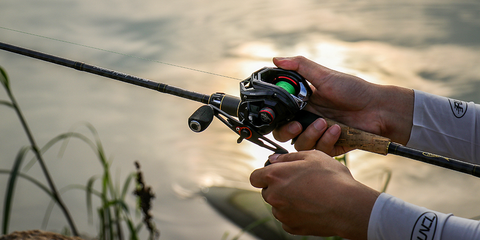What is backlash & why do baitcasters suffer from it?

Backlash happens when the lure slows down after casting, but the spool does not—resulting in a tangled mess of line, also known as a “bird's nest.”
It usually happens when you don’t have the spool and brake system set properly, it can happen if you aren’t using the right rod, and it can happen if you are not using the right line and lures.
The bottom line is that backlash with baitcasting rods is a mess that you absolutely want to avoid.
How to prevent backlash on your casting reel?
Backlash is what usually discourages people from using a baitcasting reel. However, there are many advantages to using a baitcaster rather than a spinning reel—such as allowing for more precision and control, giving you a more accurate cast. Then we will tell you a few ways to help prevent, or lessen backlash.
1. Choose the right (not expensive) equipment

When just starting, you want to choose the right fishing line to make it easier to untangle a bird’s nest.
Monofilament line causes the least backlash and is the easiest fishing line to untangle than a braided line or fluorocarbon line.
A heavy lure works better for baitcasting when you’re just beginning. The heavier lure will keep constant pressure on the line. When you go lighter you have to really pay attention to your arm/wrist position and how you are moving the rod. Normally, you snap the wrist with a Spinning Rod get the maximum distance but if you do that with a baitcaster rigged light, you will backlash every time. A baitcasting reel is more of a whole arm type of cast. If you could see in slow motion what happens when you snap your wrist with a bait caster, you would see a hump in your line heading out towards your lure and then traveling back to your reel. When it gets back (very quickly by the way) you get your backlash.
2. Adjust spool tension & the brake system & do a test cast

In the beginning, you need to ensure that your spool tension is set just right. You want your lure to fall at neither too high nor low of speed—but at a medium pace. There is no correct setting, so use trial and error to see where you feel most comfortable.
Just as important, you want to set the brake system to the highest setting. This gives you more control and allows less movement while you practice. When you become more comfortable, you can begin to lower the tension to allow longer baits.
3. Do not cast your lure against the wind
Casting against the wind will slow down your lure, but not your reel, resulting in backlash. As you become more comfortable with your reel and gain experience, you can begin casting into the wind.
If it’s possible, try practice casting in your backyard so you can have some control of your surroundings.
Once you’ve gotten the feel for your baitcaster, test it out on the water. You can experiment with different braking and tension settings to see which is most comfortable. When you feel that you are getting the hang of it, you can try investing in a more advanced bait caster. The most important: practice more, then you will handle it like a pro!

